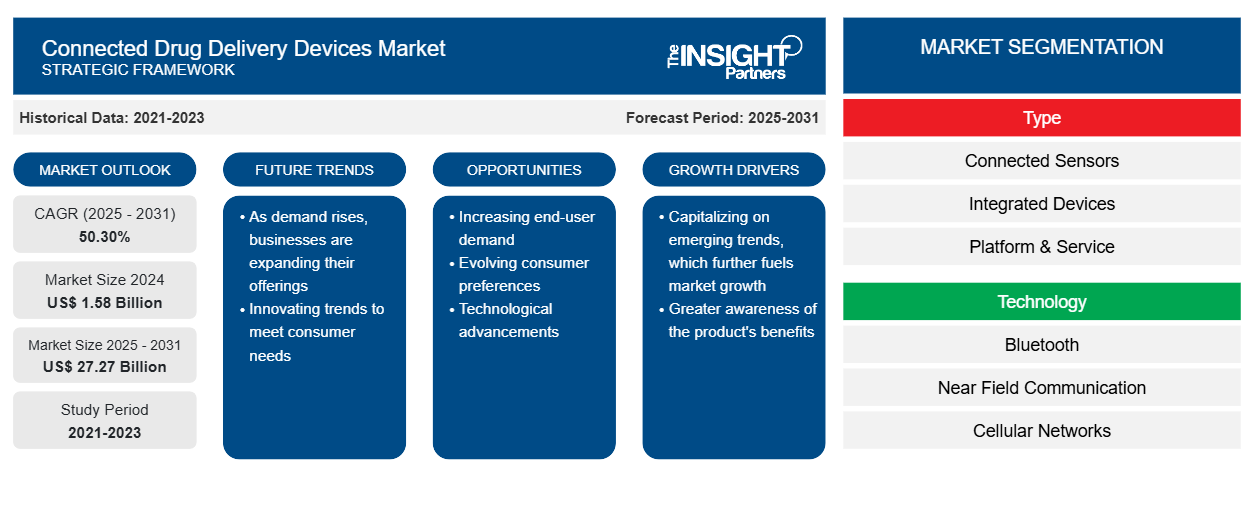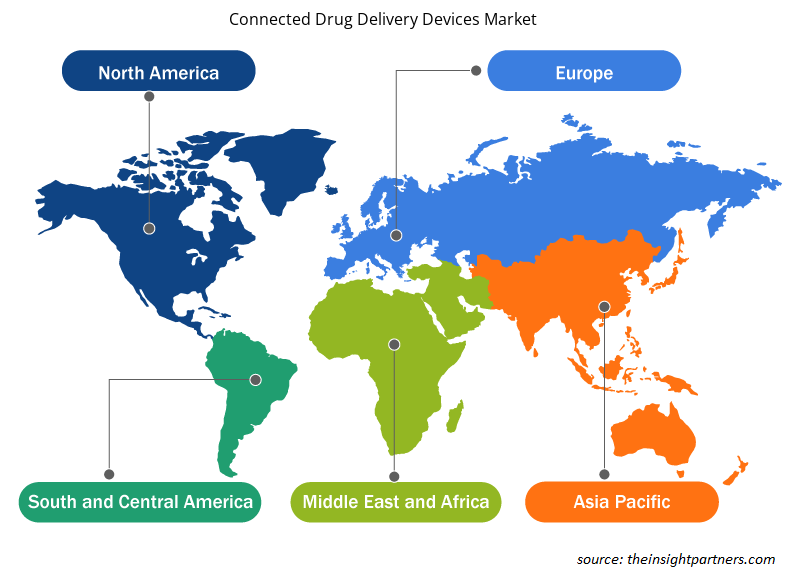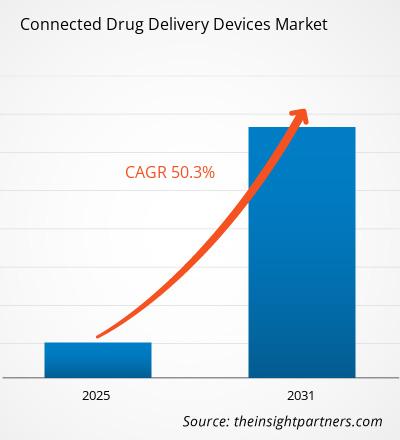The connected drug delivery devices market is expected to grow from US$ 463.59 million in 2021 to US$ 7,998.09 million by 2031; it is expected to grow at a CAGR of 50.3% from 2022 to 2031.
The increasing number of patients suffering from diabetes, asthma, hypertension, tuberculosis, multiple sclerosis, clinically isolated syndrome, chronic obstructive pulmonary disease (COPD), hepatitis C, and other chronic diseases and the growing emphasis of healthcare professionals on preventive care drive the growth of the connected drug delivery devices market. Connected drug delivery devices are made by using embedded electronics and sensors. The devices are designed to collect information on self-administration and transmit real-time dose compliance data from the device to the patient’s smartphone and the HCP’s database. As a result of drug delivery connectivity, the remote compliance helps highlight potential complications that could lead to poor treatment outcomes. During COVID-19 outbreak, patients were restricted from visiting hospitals to avoid the spread of the virus infection. Thus, to maintain social distancing, patients and healthcare professionals depended on self-administration and remote monitoring.
MARKET DYNAMICS
The growth of the connected drug delivery devices market is majorly attributed to the increasing number of patients affected by chronic diseases, growing demand for remote patient monitoring, and rising demand from the geriatric population. However, the high cost of the devices hampers the growth of the market. Moreover, the adoption of partnerships, mergers & acquisitions, collaborations, and other strategic initiatives among market participants is expected to propel the market growth during the forecast period.
MARKET SCOPE
The “Global Connected Drug Delivery Devices Market Forecast to 2031” report aims to provide an overview of the connected drug delivery devices market with detailed market segmentation based on type, technology, and end user. The report provides key market statistics based on the financial performances of the leading players. It also offers key trends and opportunities in the market.
Customize This Report To Suit Your Requirement
You will get customization on any report - free of charge - including parts of this report, or country-level analysis, Excel Data pack, as well as avail great offers and discounts for start-ups & universities
Connected Drug Delivery Devices Market: Strategic Insights

- Get Top Key Market Trends of this report.This FREE sample will include data analysis, ranging from market trends to estimates and forecasts.
You will get customization on any report - free of charge - including parts of this report, or country-level analysis, Excel Data pack, as well as avail great offers and discounts for start-ups & universities
Connected Drug Delivery Devices Market: Strategic Insights

- Get Top Key Market Trends of this report.This FREE sample will include data analysis, ranging from market trends to estimates and forecasts.
MARKET SEGMENTATION
The global connected drug delivery devices market is segmented on the basis of type, technology, and end user. Based on type, the market is segmented into connected sensors, integrated devices, and platform & services. The market for the connected sensors segment is further bifurcated into connected inhaler sensors and connected injection sensors. The market for the integrated devices segment is subsegmented into connected inhaler devices and connected injection devices. Based on technology, the global connected drug delivery devices market is segmented into Bluetooth, cellular networks, near field communication (NFC), and others. The market, by end user, is segmented into hospitals, homecare, and others.
REGIONAL FRAMEWORK
The global connected drug delivery devices market is segmented into five major regions—North America, Europe, Asia Pacific, Middle East & Africa, and South & Central America. The report covers an analysis and forecast of 18 countries across the world along with trends and opportunities prevailing in the region.
From the regional perspective, North America dominates the connected drug delivery devices market with ~35% market share in 2021. Rising per capita expenditure of healthcare and the increasing adoption of advances in product launches and related innovations bolster the growth of the regional market. The below figure shows the revenue growth trend in the connected drug delivery devices market:
The report analyzes factors, such as drivers, restraints, opportunities, and future trends, which impact the connected drug delivery devices market. It also provides an exhaustive Porter's five forces analysis of the factors influencing the market.
IMPACT OF COVID-19 PANDEMIC
During COVID-19 outbreak, the demand for connected drug delivery devices increased, which led to a high volume of orders among drug manufacturers, resulting in a higher production volume of connected sensors. Thus, owing to the COVID-19 crisis and the transition of individuals and healthcare professionals to adopt remote patient monitoring methods have bolstered the demand for connected drug delivery devices at the recent past. The trend is expected to continue during the forecast period.
MARKET PLAYERS
The report covers key developments in the connected drug delivery devices market. Various companies are focusing on organic growth strategies, such as product launches, product approvals, patents, and events. Inorganic growth strategies, such as acquisitions, partnerships, and collaborations, have encouraged the expansion of business and the customer base of market players. The players operating in the connected drug delivery devices market are anticipated to experience lucrative growth opportunities in the coming years owing to the rising demand for connected drug delivery devices.
The report includes the profiles of key connected drug delivery devices market companies, along with their SWOT analysis and market strategies. In addition, it focuses on leading industry players’ company profiles, components and services offered, financial information for the last three years, and key developments in the past five years. The list of a few companies engaged in the connected drug delivery devices market is mentioned below:
- Propeller Health
- Adherium Limited
- West Pharmaceutical Services
- FindAir
- Phillips-Medisize
- Biocorp
- 3M
- Cohero Health
- Merck Group
- Other Market Participants
The Insight Partner's dedicated research and analysis team consists of experienced professionals with advanced statistical expertise and offers various customization options in the existing study.
Report ScopeConnected Drug Delivery Devices Market Regional Insights
The regional trends and factors influencing the Connected Drug Delivery Devices Market throughout the forecast period have been thoroughly explained by the analysts at Insight Partners. This section also discusses Connected Drug Delivery Devices Market segments and geography across North America, Europe, Asia Pacific, Middle East and Africa, and South and Central America.

- Get the Regional Specific Data for Connected Drug Delivery Devices Market
Connected Drug Delivery Devices Market Report Scope
| Report Attribute | Details |
|---|---|
| Market size in 2024 | US$ 1.58 Billion |
| Market Size by 2031 | US$ 27.27 Billion |
| Global CAGR (2025 - 2031) | 50.30% |
| Historical Data | 2021-2023 |
| Forecast period | 2025-2031 |
| Segments Covered |
By Type
|
| Regions and Countries Covered | North America
|
| Market leaders and key company profiles |
Connected Drug Delivery Devices Market Players Density: Understanding Its Impact on Business Dynamics
The Connected Drug Delivery Devices Market is growing rapidly, driven by increasing end-user demand due to factors such as evolving consumer preferences, technological advancements, and greater awareness of the product's benefits. As demand rises, businesses are expanding their offerings, innovating to meet consumer needs, and capitalizing on emerging trends, which further fuels market growth.
Market players density refers to the distribution of firms or companies operating within a particular market or industry. It indicates how many competitors (market players) are present in a given market space relative to its size or total market value.
Major Companies operating in the Connected Drug Delivery Devices Market are:
- Phillips-Medisize
- West Pharma
- Aterica Inc.
- Panasonic Corporation
- BIOCORP
Disclaimer: The companies listed above are not ranked in any particular order.

- Get the Connected Drug Delivery Devices Market top key players overview
- Historical Analysis (2 Years), Base Year, Forecast (7 Years) with CAGR
- PEST and SWOT Analysis
- Market Size Value / Volume - Global, Regional, Country
- Industry and Competitive Landscape
- Excel Dataset
Testimonials
Reason to Buy
- Informed Decision-Making
- Understanding Market Dynamics
- Competitive Analysis
- Identifying Emerging Markets
- Customer Insights
- Market Forecasts
- Risk Mitigation
- Boosting Operational Efficiency
- Strategic Planning
- Investment Justification
- Tracking Industry Innovations
- Aligning with Regulatory Trends
Yes! We provide a free sample of the report, which includes Report Scope (Table of Contents), report structure, and selected insights to help you assess the value of the full report. Please click on the "Download Sample" button or contact us to receive your copy.
Absolutely — analyst assistance is part of the package. You can connect with our analyst post-purchase to clarify report insights, methodology or discuss how the findings apply to your business needs.
Once your order is successfully placed, you will receive a confirmation email along with your invoice.
• For published reports: You’ll receive access to the report within 4–6 working hours via a secured email sent to your email.
• For upcoming reports: Your order will be recorded as a pre-booking. Our team will share the estimated release date and keep you informed of any updates. As soon as the report is published, it will be delivered to your registered email.
We offer customization options to align the report with your specific objectives. Whether you need deeper insights into a particular region, industry segment, competitor analysis, or data cut, our research team can tailor the report accordingly. Please share your requirements with us, and we’ll be happy to provide a customized proposal or scope.
The report is available in either PDF format or as an Excel dataset, depending on the license you choose.
The PDF version provides the full analysis and visuals in a ready-to-read format. The Excel dataset includes all underlying data tables for easy manipulation and further analysis.
Please review the license options at checkout or contact us to confirm which formats are included with your purchase.
Our payment process is fully secure and PCI-DSS compliant.
We use trusted and encrypted payment gateways to ensure that all transactions are protected with industry-standard SSL encryption. Your payment details are never stored on our servers and are handled securely by certified third-party processors.
You can make your purchase with confidence, knowing your personal and financial information is safe with us.
Yes, we do offer special pricing for bulk purchases.
If you're interested in purchasing multiple reports, we’re happy to provide a customized bundle offer or volume-based discount tailored to your needs. Please contact our sales team with the list of reports you’re considering, and we’ll share a personalized quote.
Yes, absolutely.
Our team is available to help you make an informed decision. Whether you have questions about the report’s scope, methodology, customization options, or which license suits you best, we’re here to assist. Please reach out to us at sales@theinsightpartners.com, and one of our representatives will get in touch promptly.
Yes, a billing invoice will be automatically generated and sent to your registered email upon successful completion of your purchase.
If you need the invoice in a specific format or require additional details (such as company name, GST, or VAT information), feel free to contact us, and we’ll be happy to assist.
Yes, certainly.
If you encounter any difficulties accessing or receiving your report, our support team is ready to assist you. Simply reach out to us via email or live chat with your order information, and we’ll ensure the issue is resolved quickly so you can access your report without interruption.















The List of Companies
1. Phillips-Medisize
2. West Pharma
3. Aterica Inc.
4. Panasonic Corporation
5. BIOCORP
6. Merck KGaA
7. Propeller Health
8. Proteus Digital Health
9. Adherium Limited
10. Qualcomm Technologies, Inc.






 Get Free Sample For
Get Free Sample For